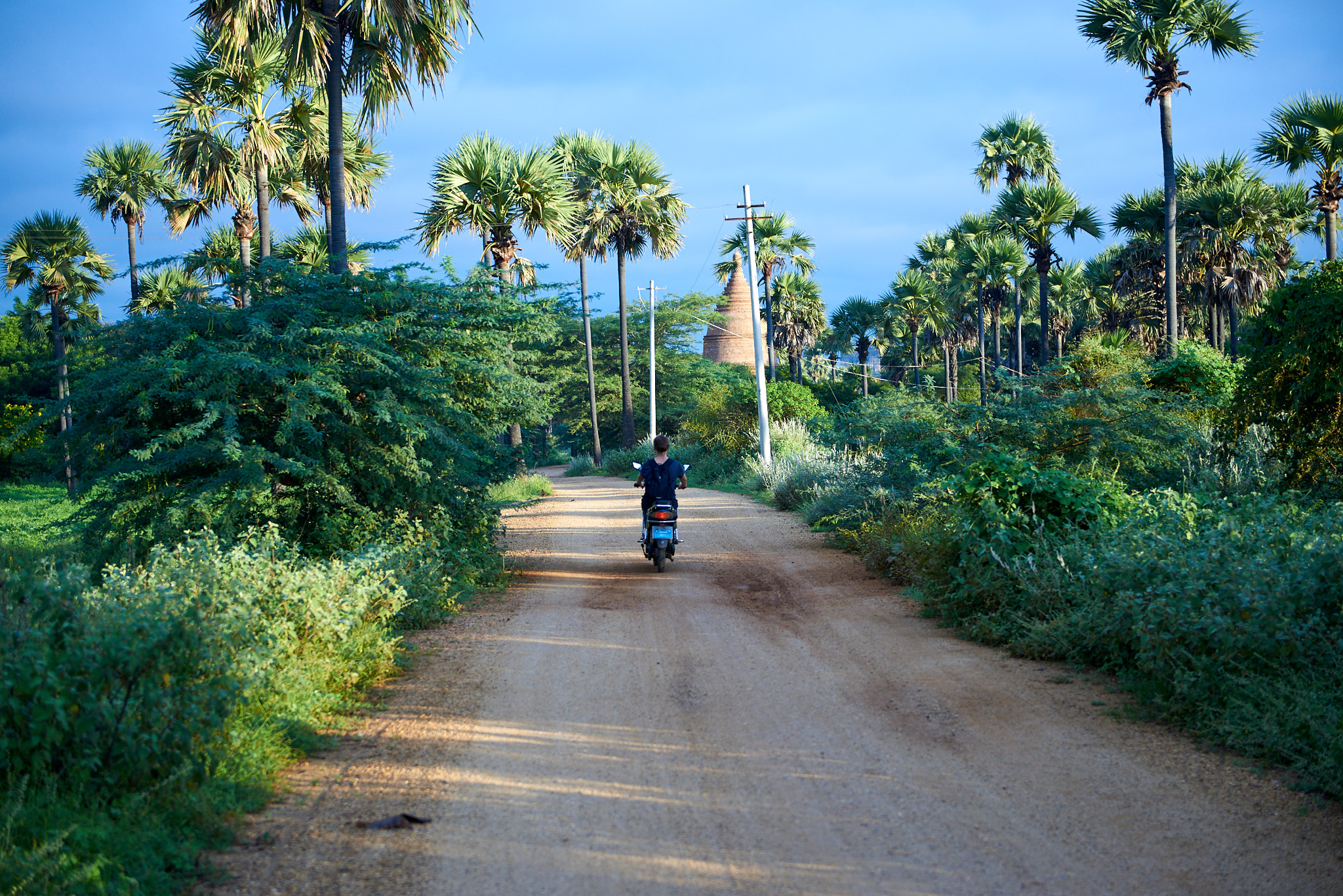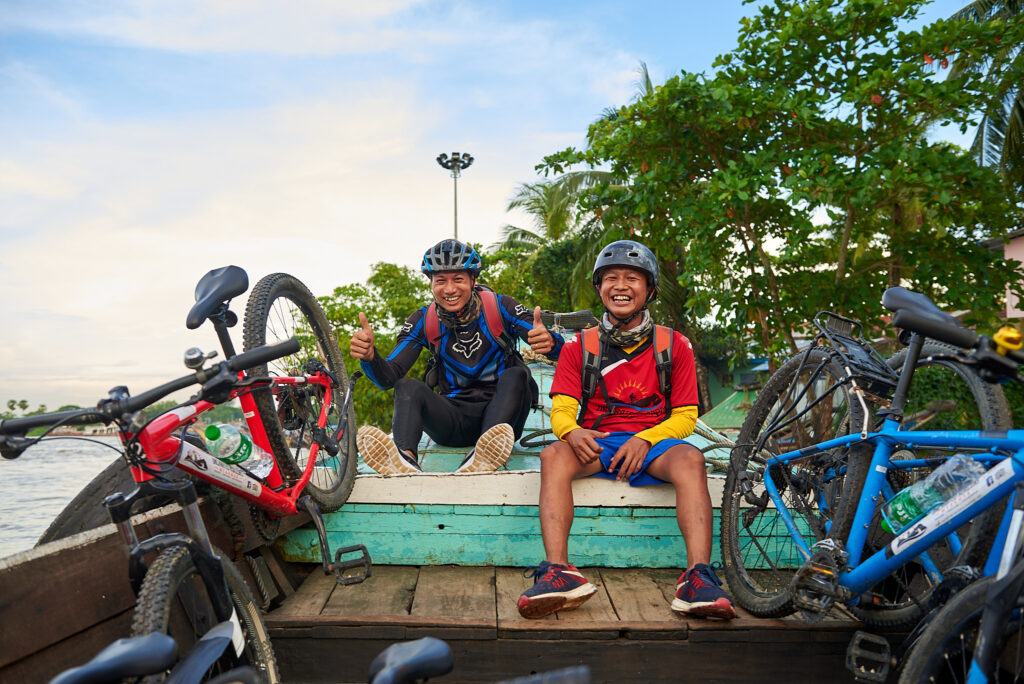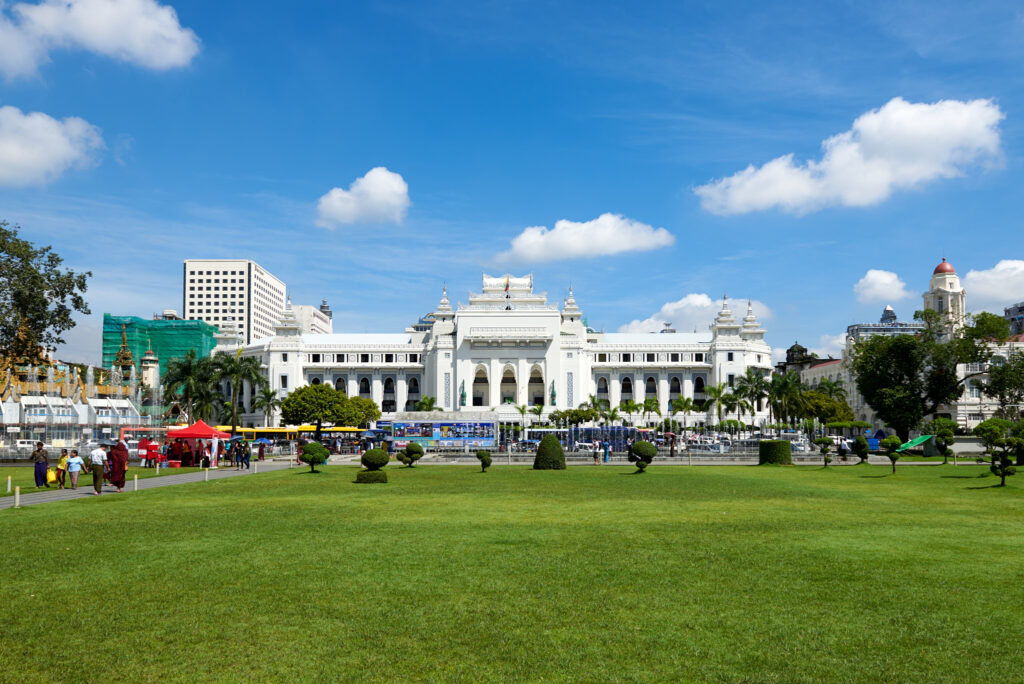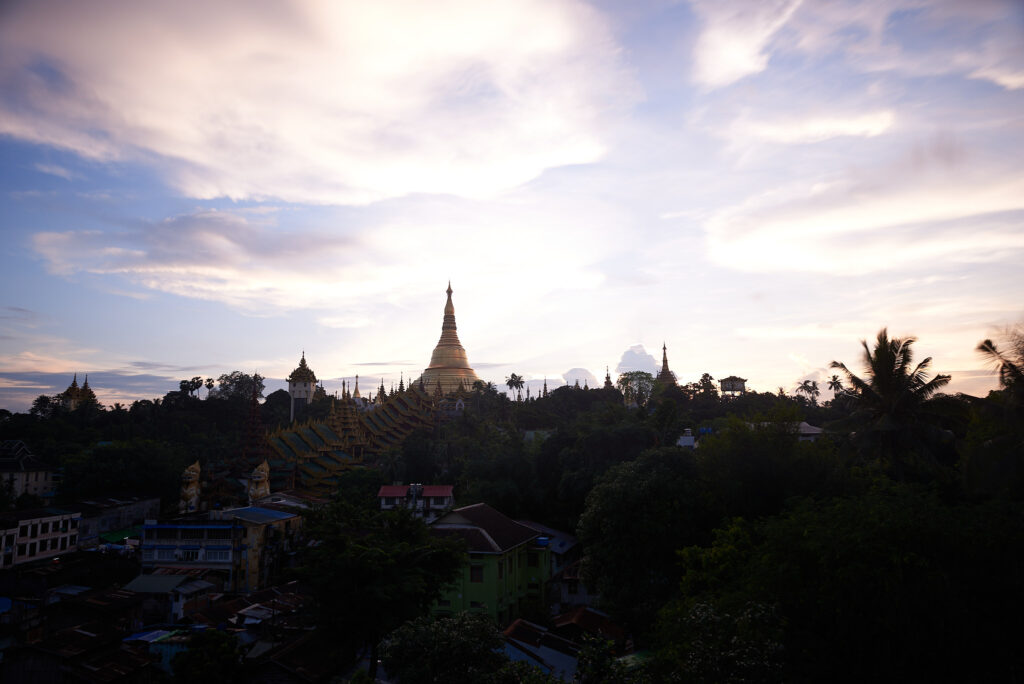Myanmar, typically known as Burma, is a country in Southeast Asia. A country that until recently, has slipped under the radar of western tourism. The borders were reopened for tourists in 2011. I’ve been fortunate to visit Myanmar twice; once in 2009 and again in 2017 and have had the opportunity to see the changing progress of the country – for better and worse! In 2009 approximately 760.000 tourists visited Myanmar while in 2017 that number was a staggering 3,440,000. That many tourists in such a short time do leave a footprint. However, there is no denying, Myanmar is a magical place which you can only fall in love with when you have roamed the many diverse cities. The golden temples, the hospitality of the local people (if you do steer away from the growing tourist traps and areas) and the many and the countless of magical sights, Myanmar should be a must on any bucket list!
Post Series
Risk Assessment of Electric Bikes in Bagan, Myanmar
As we travelled through Myanmar, we had no real idea about the adventures Bagan had…
An Insider’s Travel Guide to Yangon, Myanmar (Burma)
ⓘ THIS POST IS PART OF A SERIES CALLED: THE HEART OF MYANMAR (BURMA) Yangon…
Cycling Around Dala, Myanmar: A Photo Journal
We wanted to escape the hustle of the busy Burmese streets of Yangon and its…
Walk Around Downtown Yangon: A Photo Journal
We went for a walk around downtown Yangon where you easily can spend a full…
Shwedagon Pagoda: A Photo Journal
Shwedagon Pagoda or Paya is one of Buddhism’s most sacred sites. The 325 ft stupa…
Destinations
From metropolitan Yangon, the tranquillity of Inle Lake, the mesmerising and breathtaking Bagan to the royal Burmese identity of Mandalay!
Names of Myanmar
The country is known in English as both Myanmar and Burma. There exist two names for the country which is used in two different contexts, known as Myanma and Bama. Myanmar, in the Burmese language, is known as either Myanma (မြန်မာ) or Bama (ဗမာ). Myanma is considered the written, literacy country name while the spoken name is Bama. Today in Burmese the name is still spelt Mranma but is pronounced Myanma.
In 1989, the military regime of Burma set up a commission in charge of reviewing the place names of Burma in the English language. The commission aimed to correct the spelling of the place names of Burma in English, to discard spellings chosen by British colonial authorities in the 19th century, and adopt spellings closer to the actual Burmese pronunciation. Thus, for instance, Rangoon was changed to Yangon to reflect the fact that the “r” sound is no longer used in Standard Burmese.
Since the 1989 decision to change the English name from “Burma” to “Myanmar”, adoption of the new name in the English-speaking world has been mixed. Use of “Burma” has remained widespread, largely based on the question of whether the regime has the legitimacy to change the country’s name, particularly without a referendum. The United Nations, of which Myanmar is a member, endorsed the name change five days after its announcement. However, governments of many English-speaking countries including the United States, the United Kingdom, Australia and Canada still refer to the country as “Burma”. Following the 2011–2012 democratic reforms in Burma, politicians started using “Myanmar” more frequently [1].
The Risks of Travelling to Myanmar (Burma)
As the cautious and obnoxious analytics that I am, I drew this risk matrix for The Wife before we bought our tickets to Myanmar. As with all good decisions, they are based on well-informed background knowledge and descriptors of the context. As the protector of The Wife, I couldn’t with perfect conscience take her to a developing country without knowing the risks involved (especially when I promised her dad at our wedding that I always would have her best interest in mind!).
Knowing The Wife and her fear of flying, I knew that Myanmar would be… Well, out of her comfort zone. The notion that she instead would go by bus between Yangon, Inle Lake, Bagan and Mandalay (talk about irrational fear?!) I knew that the hazard of flying in Myanmar would be one of my highest concerns based on The Wife’s epistemological position to risk. Her view on risk [2] in this regard required me not to rely solely on the term ‘risk’ in a more technical science perspective. I had to include an intuitive understanding of risk which refers to a more multidimensional concept that cannot be reduced to the product of probabilities and consequences [3], but her perceptions of the risks.
The approach to just laugh at her didn’t seem right. I had to legitimise her epistemological approach and how she linked certain expectations, ideas, hopes, fears and emotions of flying and the inherent uncertainties [3]. Her psychological perspective to the risk of flying (especially in a partly closed country like Myanmar) required me to be creative.
The below risk matrix demonstrates some of the identified risks which I drew to her before going on our journey. As you can see, many of them are correctly below and in the green. Green = happy wife! We like green. Nonetheless, flying is in green! But in The Wife’s mind, it was red. Very very red!
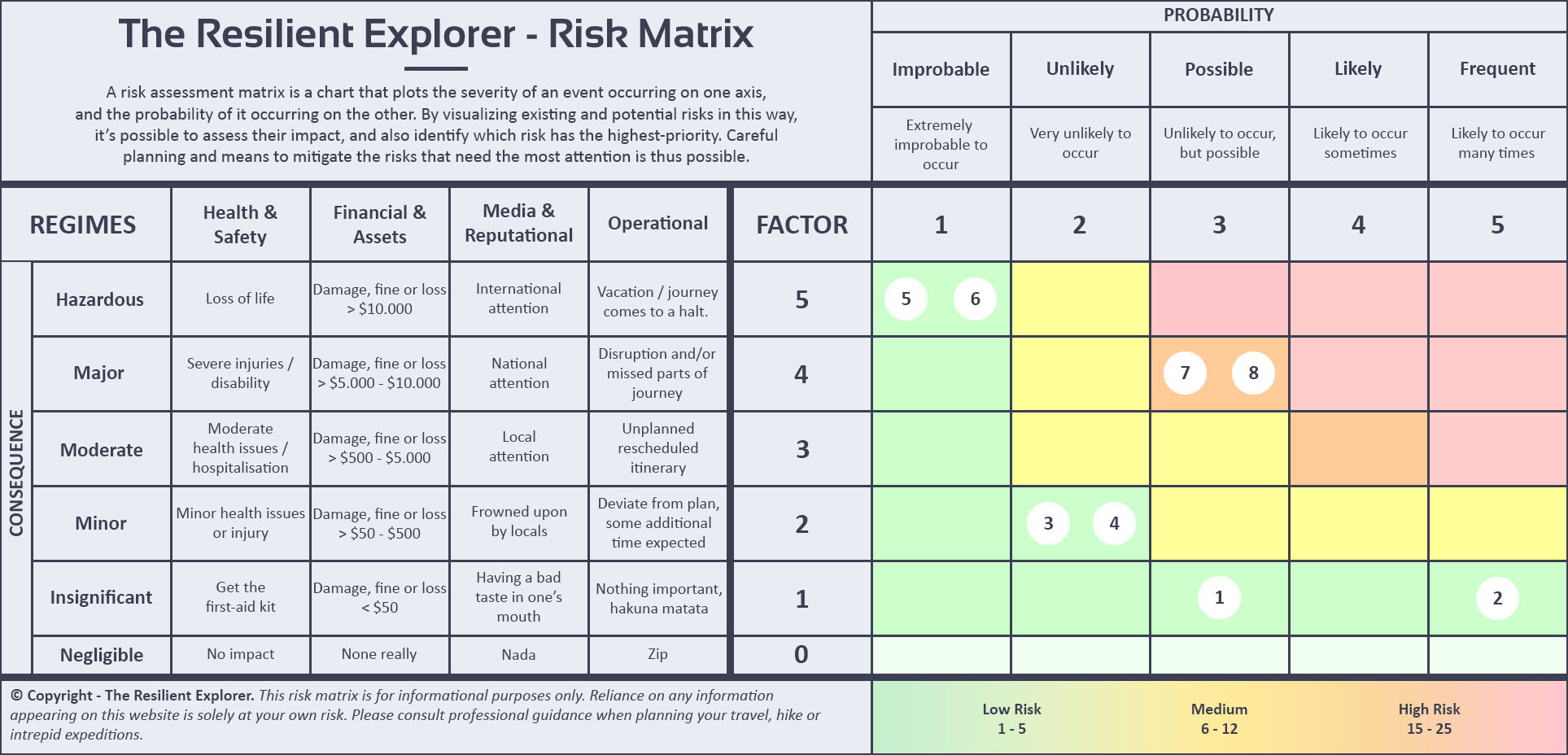
- PETTY THEFT: Just be careful and don’t flash the money to everyone. Take the usual precautions, and you should be fine.
- SUNBURN: Well, just take sunscreen factor 100, and you’ll survive!
- FOOD POISONING: Remember sanitizer, cooked food, bottled water and iodine tablets if your delicate tummy requires it. Unless it’s severe diarrhoea, nothing really to worry about.
- TORRENTIAL RAIN: Although we didn’t go in the rainy season, Myanmar can be exposed to the various elements.
- EARTHQUAKE: The statistics indicate a country exposed to earthquakes (recent include 1975, 2011, 2012, 2016×2 and 2018).
- AIRLINE SAFETY: Much debate going on online in regards to how the local Burmese airlines are performing.
- ROAD TRAFFIC: Going by local transportation mode including a scooter, e-bikes, busses and taxies. Let’s take a look at the accident statistics!
- CIVIL UNREST: Usually, mostly in Eastern part of Myanmar and the disputes between Rohingya Muslims and Buddhist Burmese people in the Rakhine State. Could be classified as a Media/Reputational issue. A military coup d’état on 1 February, staged by Min Aung Hlaing, the commander-in-chief of the country’s armed forces has created a severe situation in Myanmar.
As per the analysis, it was pretty evident for me. The goal was to ensure we flew from destination to destination. I had to rely on essential elements [4] when discussing perceptions of risks and how to influence these perceptions in an acknowledging and accommodating approach:
- Intuitive heuristics and judgements processes concerning probability and consequences;
- Contextual factors relating to the perceived characteristics of the risk and the risk situation.
No doubt, The Wife is (mostly) a rational individual. When she saw the risk matrix and statistics laid out when discussing flight vs road (she was contributing to the data collection when we looked at the accident statistics), we were halfway home. It also helped by using heuristics when she had to choose between two evils (in my optic, there was only one evil!) based on her own recognition, data collection and sound reasoning. However, she was still giving way to the fact that her personal controllability was slim to none and that she had to fly with local airline companies in Myanmar. This is where I got the idea to set up a ranking system of the operating airline companies. Giving weight to descriptors and more detailed analysis of the airline companies, I had a way to try and give her some of that controllability back (at least in a cognitive psychological way). Suddenly, it could be her ‘choice‘, her perceived characteristics of the risk and the situation in the given local context. This lead to the five-criteria ranking system, a journey to Myanmar (Burma) and a happy wife 🙂 .
Airline Safety in Myanmar
Airline safety within Myanmar has been widely discussed on the internet as there seems to exist diverging opinions of this type of travel. If anyone has ever travelled in the Asia region has experienced a rather laid back attitude towards travelling on the roads. Regardless, many people see air travel as more unsafe than travelling by bus, taxi or motorcycle on often small and unpaved roads. Trust me! Take the flight! 🙂
ⓘ AIRLINE SAFETY: YOU CAN CREATE YOUR OWN RANKING SYSTEM OF THE BEST AIRLINE OPERATORS BASED ON SEVERAL OPENLY ACCESSIBLE DATA SOURCES.
Creating a Ranking System
I made a ranking system of the various airline companies within Myanmar based on five criteria; IOSA, EU allowed, Aircraft Accidents, FAA Endorsed and ICAO Country Audit. Let us dive into it:
- IOSA is a certification that stands for the IATA (International Air Transport Association) Operational Safety Audit. It is an internationally recognised and accepted evaluation system which is designed to assess the operational management and control systems of an airline. It must be noted, that the IOSA certification is not mandatory – so either the airline either has failed the IOSA audit or simply chosen not to participate. Nonetheless, I do prefer an airline that does favour to be IOSA certified.
- Is the airline EU allowed? Some airlines are not allowed to fly within the European airspace and is thus blacklisted. EASA (European Aviation Safety Agency) updates this list continuously.
- Does the airline have had any previous aircraft accidents? Often such information is freely available and can easily be found when searching for this on Google. Be careful as some airline companies can be somewhat new and have thus not operated for a long enough period. Also, external factors could cause an aircraft accident which should not be attributed to the airline itself. Such incidents could pertain to acts of terrorism, runway incursion in the active runway (e.g. a vehicle or person unauthorised on the runway). This factor should (almost) always include pilot error and technical failure as it can indicate the training and the condition of the aircraft.
- FAA Endorsement can be compared to EU blacklist counterpart, as FAA is the United States Federal Aviation Authority which similarly has a blacklist of several airlines. However, a ban from FAA is given to a country (not airlines) and is given to those that are deemed inability to adhere to international aviation standards for aircraft operations and maintenance.
- The International Civil Aviation Organization has eight safety parameters which form the ICAO country audit. ICAO was established to promote the safe and orderly development of international civil aviation throughout the world. The 8 ICAO audit parameters that pertain to safety are; Legislation, Organisation, Licensing, Operations, Airworthiness, Accident Investigation, Air Navigation Service and Aerodromes. Please note, that this is a country audit and if you only fly national within Myanmar, this might not give much value. However, if you use an airline that operates across borders (e.g. Myanmar to Thailand), that very airline might be subject to stricter requirements and therefore more safety for passengers. One can compare various countries via ICAO.
Choosing Road Travel Rather Than Air?
According to Myanmar Organization for Road Safety, Myanmar has the second highest death toll of road accidents in Southeast Asia. In 2017, Mandalay alone had 5.949 car accidents and 22.519 motorcycle accidents, which results in an average of 78 road accidents every day [5].
Still thinking of hitting the road rather than the air? 😉
Notes and References
Note 1: Names Of Myanmar – Wikipedia.
Note 2: Lupton, D. (2013). Risk. Oxon: Routledge.
Note 3: Aven, T. & Renn, O. (2010). Risk Management and Governance: Concepts, Guidelines and Applications. London: Springer.
Note 4: Rohrmann, B., & Renn, O. (2000). Risk perception research: An introduction. In O. Renn & B. Rohrmann (Eds.), Cross-cultural risk perception: A survey of empirical studies (pp. 11–54). Dordrecht: Kluwer.
Note 5: Myanmar Has Second Highest Road Accident Death Toll in SEA – Myanmar Business Today.
